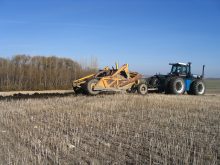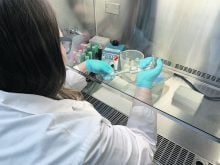Just because water is drinkable and tastes good doesn’t mean it’s suitable for spraying the fields, said Clark Brenzil.
He gives the example of water from wells in the far south and west of Saskatchewan. Typically 500 feet or more in depth, the water they produce is high quality but it’s also high in bicarbonate.
“Normally, you wouldn’t be able to tell you had these ions in the water,” he said. “It doesn’t appear as ‘hard.’ It’s considered ‘soft’ water.”
Read Also

More work wanted on removing red tape
REGINA — Canadian farmers risk falling further behind competitors if two main federal agencies don’t become more efficient and responsive…
Brenzil spoke at the Water Quality and Herbicides webinar offered through Saskatchewan Agriculture in March.
He said the problem with these waters is bicarbonate is antagonistic to some herbicides. That is, it binds with the active ingredients, effectively making those expensive crop protection products useless or at least far less effective.
Fortunately, there’s a quick fix for this particular issue: add a small amount of nitrogen liquid fertilizer. Brenzil said one per cent liquid ammonium sulphate or half a percent liquid urea is enough to do the trick. It’s important to add it and mix well before adding the herbicide, so the nitrogen can bind with the bicarbonate, and to use the right N formulation.
“You want to make sure you’re using spray-grade liquid in these cases and that’s just basically to avoid the formation of crystals that can plug nozzles,” he said.
The ammonia can actually give glyphosate a bit of a boost, Brenzil said, possibly because it helps the chemical get through the plant cell walls to do its job better.
Lest anyone gets the idea they can do micronutrient application while spraying, it turns out that other elements such as manganese and especially zinc also bind very nicely with some herbicides.
“We want to make sure we’re not adding these into our glyphosate solutions as a way to do two things at once by adding micronutrients,” he said.
Glyphosate as well as 2,4-D amine are also antagonized by other elements (typically in the form of salts) commonly dissolved in water, such as calcium, magnesium and iron. Other weak acid herbicides such as aminopyralid (e.g. Restore and Reclaim) can also be impaired by dissolved salts.
Effects can vary by crop as well. Clethodim (e.g. Select and Centurion) is a Group 1 herbicide vulnerable to bicarbonate but it’s much more active in oats than barley. This means the product could perform fine against oats and wild oats and fail to control volunteer barley.
Another Group 1 herbicide, tralkoxydim (e.g. Achieve) is hindered by bicarbonate too, but also by time of day.
“When it’s sitting on the leaf’s surface, there can be degradation by UV radiation,” Brenzil said. “It’s typically when you have a piling on of different stresses. Maybe you’re a little bit late on the staging, maybe you’ve cut your water volume a little bit, maybe you’re applying in the morning … with bicarbonate water – that’s when you’re going to see things pile up and cause a failure.”
This time-of-day sensitivity is reversed for sethoxydim (e.g. Poast), another Group 1 product, underlining the complexity of water, product and environmental conditions. This means getting spray water tested and seeking expert advice as needed. Brenzil said testing typically costs a bit of extra time and $100-$120 per sample – trivial compared to the total cost of spraying operations.
“You’re spending a lot of money on herbicides and you want them to work optimally,” he said. “It’s best to get the hard numbers right from the lab.”
The most common element to show up in “hard” water is calcium, whether it is calcium bicarbonate, calcium carbonate or calcium chloride. Indeed, water hardness test results are given as “calcium carbonate equivalent” no matter what elements are present. CCE is expressed in parts per million or milligrams per litre, which are essentially the same thing.
“They do that to make it so it’s comparable as well as being additive so you can add them together and get a total hardness value,” Brenzil said.
Ammonium sulphate can also be used to correct for dissolved calcium and magnesium in spray water. There’s even a free online tool for glyphosate developed by researchers at Washington State University to calculate just how much is needed, based on water test results bit.ly/3PyP2jc.
“What it will spit out is the amount of ammonium sulphate you need to put in that spray water in order to neutralize those ions,” Brenzil said.
Ammonium sulphate won’t fix iron or zinc issues; for this citric acid and ammonium citrate can be used (the latter is a rather expensive food additive and so likely not practical). Even sulphuric acid would work for calcium and magnesium, but it’s not a good idea.
“I don’t know that I’m particularly comfortable with people dumping battery acid – car battery acid – into their sprayers in order to try and correct for water quality concerns when we have other things like citric acid,” he said. “You’re getting the same result as with ammonium sulphate as you would with sulphuric acid but you’re not risking burning a hole in your hand, so to speak, or splashing it up in your eye and losing an eye.”
Contact herbicides from Groups 6, 9 and 12 (glyphosate is Group 9) can also be stymied by suspended clay and organic material, although the issue varies by type. For example, Brenzil said glyphosate (Group 9) and diquat (e.g. Reglone, Group 22) bind very tightly to these contaminants while Group 6 products can tolerate quite a lot of this type of interference before their effectiveness starts to fall off.
Again, pre-treating water before it goes into the spray tank is key. For surface water from dugouts, for example, a dose of alum to clear out the clay and one of copper sulphate to take care of excessive algae will help. Filters to clear out organic matter and an opaque tank to block light and prevent further algae growth are also simple steps.

















